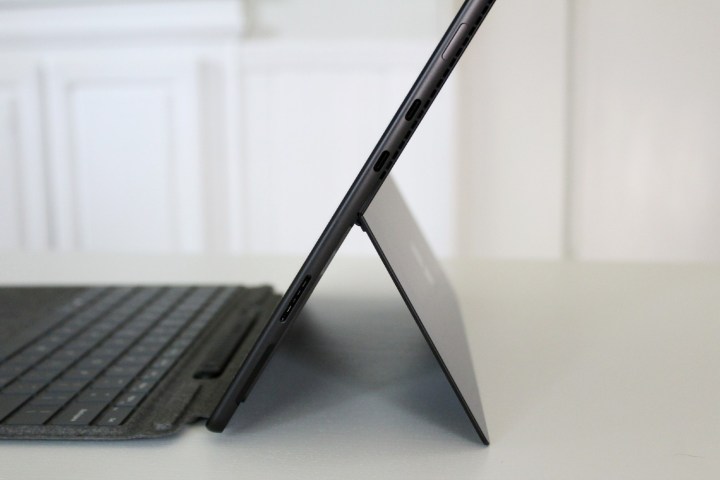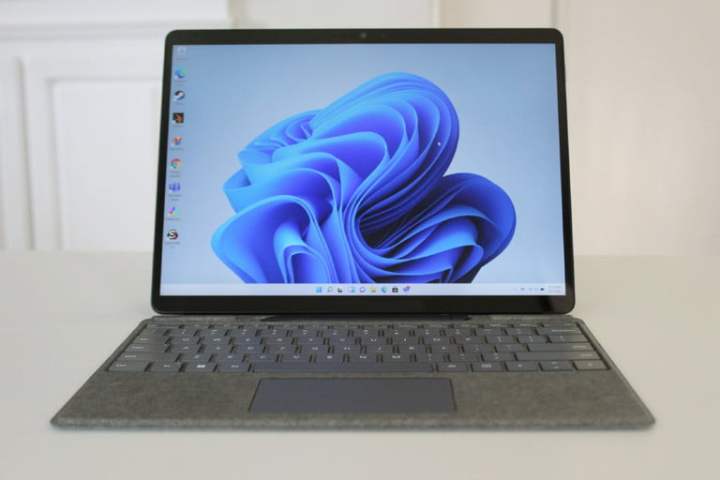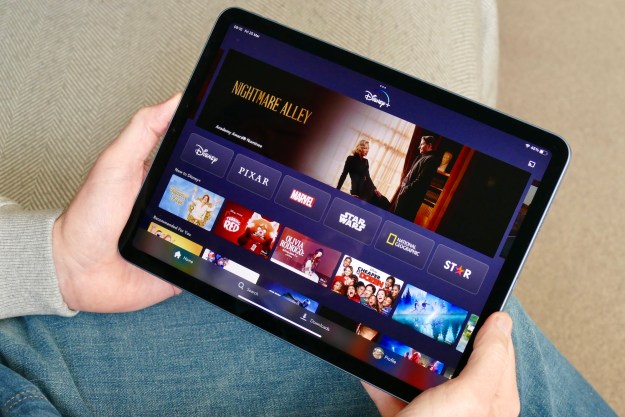
“The Surface Pro 8 is easily the best Windows 2-in-1 you can buy.”
- Gorgeous, 120Hz screen
- Impressive performance
- Has two powerful Thunderbolt 4 ports
- SSD is easily accessible
- The Surface Slim Pen 2 is exceptional
- More expensive
- Still lacks mobile apps
For the past 6 years, every version of the Surface Pro has looked nearly identical. And while Microsoft tends to take its time with its product changes, the Surface Pro, in particular, has been long overdue for an update.
That’s exactly what the Surface Pro 8 is — and it couldn’t have arrived at a better time. Preloaded with the brand new Windows 11, the Surface Pro 8 feels like a device that has a chance of taking on the iPad Pro. The price increase aside, the Surface Pro 8 is a near-perfect 2-in-1, which is finally a category of product that is starting to live up to its potential.
Design

If you don’t have the Surface Pro 8 set up next to the previous year’s model, you might not recognize the difference at first. It has the same iconic kickstand, the same overall shape, and connects to the Type Cover keyboard in the same way.
However, the Surface Pro 8 is slightly larger and heavier than the Surface Pro 7. It’s 0.04 inches thicker at 0.37 inches and 0.22 pounds heavier. That’s never a good thing when it comes to a tablet that’s meant to be held one-handed.
But there are two legitimate reasons for the larger dimensions. First, the Surface Pro 8 is made out of recycled aluminum instead of magnesium. Microsoft says this is a more sustainable method, as well as providing the device with a more premium finish. The Surface Pro was always a rigid device, but I’m sure the change to aluminum helps in that regard as well.
The second reason for the larger size? Well, it has a significantly larger screen. The Surface Pro 8 now has a 13-inch screen, up from 12.3 inches in the previous model. By trimming the bezels surrounding the screen, Microsoft squeezes as much extra screen real estate into the device without growing the overall dimensions too noticeably.

Still, when you compare it to the iPad Pro, the extra girth makes the Surface Pro 8 more difficult to handle as a tablet. I’m not saying it’s a chore to use the Surface Pro 8 as a tablet — far from it. But the 1.5-pound iPad Pro does feel more portable in comparison, and won’t strain your wrist as much while holding it one-handed.
The Type Cover, which is still sold separately, also has been updated. The biggest change is that the new Surface Slim Pen 2 fits brilliantly into the slot above the keyboard. It charges here, and can even be hidden away when you raise the keyboard. It’s nice to have a permanent spot for the stylus to (hopefully) avoid losing it so much.
Many of these changes were first made in the original Surface Pro X, which launched back in 2018. I’m delighted to see those changes come to the Surface Pro 8, though, modernizing the design and more closely matching the size of the 12-inch iPad Pro.
Ports

Microsoft doesn’t have the best history with ports, but the Surface Pro 8 is making amends. The Surface Pro 8 finally features Thunderbolt 4, which is a first for the Surface Pro line.
The Surface Pro 8 includes two of these ports, along with the Surface Dock magnetic connection, and a headphone jack.
Unfortunately, all these ports are located on the same side, meaning you don’t have a power connection on the left side at all. Like all recent Surface Pros, the Surface Pro 8 includes quick access to the storage. Under the kickstand, you’ll find a small panel that can be accessed using a SIM card eject pin. Accessing your storage doesn’t get much easier than that.
The Surface Slim Pen 2 and Type Cover
The original Surface Pen was round and heavy, create to simulate the feeling of using a real pen. But the Surface Slim Pen, first introduced with the Surface Pro X, is a fantastic alternative. The flat design fits nicely in your hand, and the lighter feel makes it less intimidating. The fact that it has a place to be stored away is icing on the cake.
But the Surface Slim Pen 2 brings one significant update to the mix: Haptic feedback. It’s the kind of thing you have to feel yourself to understand, but the slightest bit of haptic feedback is built into the pen to simulate the feeling of writing on paper. Glide the pen across the glass lightly, and you won’t notice it. But push a little harder, and you’ll feel the sensation of artificial friction.

It’s extremely subtle, but it adds the slightest bit of realism to writing and illustrating. More than that, it’s a brilliant idea that’s well executed.
The new Type Cover looks and feels identical to the previous model, except with a charging slot for the Surface Slim Pen 2. The keyboard and touchpad remain unchanged, which is a good thing. The full-sized keyboard is comfortable and tactile, featuring the standard Surface keyboard layout.
The touchpad, meanwhile, feels precise and smooth. I always wish it was a little bigger, but considering this is a keyboard attachment, it’s surprisingly good.
Display

The display on the Surface Pro 8 isn’t just bigger, it’s also faster. The 13-inch panel now comes with a 120Hz refresh rate, though it ships with 60Hz enabled. But trust me, once you use the 120Hz screen, you won’t want to go back. While the Surface Pro 8 isn’t a gaming machine, the faster screen is a quality of life improvement across the board. Animations are smoother, scrolling feels more fluid, and it even reduces latency when inking with the Surface Pen. All the new animations in
The screen also has a slightly higher resolution at 2880 x 1920. It’s still 3:2 though, and is still 267 pixels per inch. The Surface Pro devices have always had sharp screens, and this one is no different.
The Surface Pro 8’s screen is also brighter than the previous model with a max of 409 nits. In the new “Vivid” color mode, the device sports better color saturation with 99% sRGB and 79% AdobeRGB. That’s not quite as good as the Surface Laptop Studio, but it’s suitable for the type of device the Surface Pro 8 is meant to be.
Across the board, the display feels like the most important improvement on the Surface Pro 8 — and because it’s a tablet, that’s a big deal.
Windows 11 and software

The Surface Pro always had one major hang-up: Windows 10. The lack of optimization for touch made the Surface Pro (and all Windows tablets).
It’s still not an operating system designed first and foremost for touch, like iPadOS, but Windows 11 has gone a long way toward at least improving the tablet experience.
The one missing feature is Android apps, which still haven’t shown up. That leaves a hole in the app ecosystem for mobile apps, which is something the iPad Pro excels at. Even then, the inclusion of
Cameras and speakers
The Surface Pro has always had a great video conferencing experience, thanks to its great webcam and excellent speakers. Tablets tend to have much better webcams than
But overall, the camera does a fantastic job of balancing skin tones and not blowing out your background. Your colleagues will thank you for switching from a laptop camera to the Surface Pro 8. Seriously, it already happened to me.
Though you probably won’t ever use it, the Surface Pro 8 also includes a 10-megapixel camera on the back, which can shoot
The Surface Pro 8 pairs those cameras with a fantastic set of speakers. Again, tablets tend to excel in audio compared to
Microsoft also highlighted its “volume-dependent EQ” feature, which ensures that even at lower volumes, the audio still has plenty of bass. There’s a clarity and fullness to the audio that I wish
Performance
Despite the name, the Surface Pro 8 isn’t a true “pro” device. It doesn’t have a discrete GPU, and the quad-core Intel processor is run-of-the-mill. My configuration came with a Core i7-1185G7, which is the same chip you’ll in all sorts of 13-inch
The Surface Pro 8 has new thermals, a system that Microsoft calls “active cooling.” Using carbon composite heat spreaders and fans, the Surface Pro 8 remains a fairly quiet yet powerful 2-in-1. The fanless configurations are gone, though, meaning all versions of the Surface Pro 8 have this same cooling system.
The result? Well, multi-core performance and integrated Intel Iris Xe graphics performance were both highlights, with the Surface Pro 8 leading the pack among other convertible 2-in-1s and 13-inch
This led to solid real-world performance in an application like Handbrake, where, again, the Surface Pro 8 is among the fastest in its size. Calling it the most powerful Windows tablet or 2-in-1 feels accurate.
| Geekbench 5 (single/multi) |
Cinebench R23 (single/multi) | Handbrake (seconds) | PCMark 10 | 3DMark Time Spy | |
| Surface Pro 8(Core i7-1185G7) | 1296 / 5041 | 1287 / 5431 | 185 | 4169 | 1828 |
| ThinkPad X12 Detachable (Core i5-1130G7) | 1352 / 4796 | 1125 / 3663 | 188 | 4443 | 926 |
| Dell Latitude 7320 Detachable (Core i7-1180G7) | 1532 / 5031 | 1246 / 3339 | 247 | 4410 | 1443 |
| Dell XPS 13 (Core i7-1185G7) | 1549 / 5431 | 1449 / 4267 | 204 | 3859 | 1589 |
| MSI Summit E13 Flip Evo (Core i7-1185G7) | 1352 / 4891 | 1360 / 4392 | 203 | 4872 | 1751 |
That being said, don’t expect to enjoy
This applies to gaming just as much as content creation. While the Surface Pro 8’s discrete graphics are more admirable for what they are, it’s not able to play many modern games at high enough frame rates.
Battery life

Microsoft says that thanks to having a larger battery, the Surface Pro 8 can now last up to 16 hours on a single charge. That’s quite a claim. It topped out at 10 hours and 48 minutes in our lightest battery life test, which loops a local 1080p video clip until the system dies. There are plenty of
I also tested the Surface Pro 8 in web browsing, cycling through a series of heavy websites until the battery dies. Here, the Surface Pro 8 lasted 8 and a half hours. If your workflow involves multiple applications, tabs, and media streaming, however, you can expect the battery to dip by an hour or two, depending on your tasks. That means the Surface Pro 8 likely won’t last through the entirety of a workday without a recharge.
It also doesn’t have the incredible standby longevity like the iPad Pro.
Still, the Surface Pro 8 is an improvement over the previous configuration by a couple of hours. It’s an area I’d like to see improvement in, but it’s no longer a huge hang-up for me.
Configurations and price
The Surface Pro 8 isn’t just a major change to the design of the line — it also alters the pricing scheme. The Surface Pro 7 started at $750 for a Core i3 base configuration. This wasn’t the most powerful option, but it was a cheap way to get a premium piece of hardware.
The Core i3 model is gone, and the Core i5 model now starts at $1,100. That’s $200 more expensive than in the previous generation, and matches the 12.9-inch iPad Pro to a beat. Unfortunately, like with the iPad Pro, this base model still includes just 128GB of storage.
Microsoft tends to be among the most expensive manufacturers when it comes to adding storage and

From there, things get wildly expensive and unnecessary. I can’t think of a reason why you’d buy the $2,600 model with 32GB of
And, of course, the Surface Pro 8 doesn’t come bundled with either the Type Cover or Surface Slim Pen 2. Adding on those two accessories will cost you an extra $410.
Our take
The Surface Pro 8 is easily the best Surface Pro ever made. Its screen is bigger, faster, and brighter, its performance is stronger than ever, and even the battery life has been improved. That alone will convince Surface fans to upgrade.
But it’s
Are there any alternatives?
The iPad Pro is the chief rival, and it’s hard to beat. The Surface Pro 8 has an upper hand being able to run normal x86 pro applications, but the iPad Pro is a much more extensive tablet app ecosystem.
The ThinkPad X12 Detachable uses a similar form factor at a cheaper price. If you really want to go cheap, the new Surface Go 3 is the true budget option.
How long will it last?
The Surface Pro 8 should last you at least four or five years. Its build quality is exceptional, while the features and components are all top-notch. Being a
Should you buy it?
Yes. It’s the most meaningful update to the Surface Pro in a long time, and it finally feels like a worthy opponent of the iPad Pro.
Editors' Recommendations
- Windows 10 Home vs. Pro vs. S mode: What’s the difference?
- Windows 12: the top features we want to see in the rumored OS
- USB-C charging laptops: Here’s what you need to know
- PC gamers are flocking to Windows 11, new Steam survey says
- The best desktop computers for 2023: Dell, HP, Apple, and more







